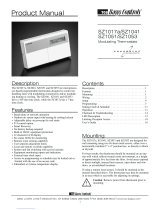
General Information
6 PKG-SVP01E-EN
other unit modules, sensors, remote panels, and customer
binary contacts) to perform the applicable request; such as
economizing, mechanical cooling, heating, ventilation.
The UCM provides some equipment protection functions
both directly and indirectly, such as duct pressure limits
and compressor lockouts. Following is a description of
each module’s function within the UCM system.
The UCM provides some equipment protection functions
both directly and indirectly, such as duct pressure limits
and compressor lockouts.
Listed below are the various modules that may be
employed in a UCM control system.
Rooftop Module Board (RTM)- Standard on all
units
The RTM is the central processor of the system. It
continuously receives information from the other unit
modules, sensors, the remote control panel, and customer
supplied relays. It then interprets this information and
responds to cooling, heating, and ventilation requests by
directing the other modules in the system to energize the
proper unit components. It also directly initiates supply
and exhaust fan operations, and economizer operation.
Compressor Module (SCM/MCM)
The Compressor module, (Single Circuit & Multiple
Circuit), upon receiving a request for mechanical cooling,
energizes the appropriate compressors and condenser
fans. It monitors the compressor operation through
feedback information it receives from various protection
devices.
Heat Module (Standard on all heating units)
The Heat module directs the unit’s heater to stage up and
down to bring the temperature in the controlled space to
within the applicable heating SETPOINT.
Exhaust/Comparative Enthalpy Module
(ECEM)(Option)
The ECEM is on units with the comparative enthalpy
option. It receives data from the return air humidity sensor,
the return air temperature sensor, and the return air space
pressure transducer and controls dampers to maintain
space pressure and humidity levels.
Generic Building Automation System (GBAS)
Module Option
The GBAS module links the RTM with non-Trane building
control systems to enable communication (input/output
interface) between the systems. It can accept external
setpoints for cooling, heating, demand limiting, and S/A
pressure.
Ventilation Override Module (VOM) Option
The VOM can control the unit’s air handling functions to
perform customerspecified functions, such as space
pressurization, exhaust, purge, unit off, etc.
Interprocessor Communications Board (IPCB)
Option
The IPCB is used to expand communication from the unit’s
UCM network to a remote human interface panel. DIP
switch settings on the IPCB module for this application
should be; switches 1 and 2 “off,” switch 3 “on.”
Trane Communications Interface Module (TCI)
Option
TheTCI module allows external setpoints for most of the
unit functions to be communicated to the unit’s UCM
network via aTrane ICS™ system. DIP switch settings on
theTCI module for these applications should be; switches
1, 2, and 3 are “off.”
BACnet Communication Interface Module
(BCI) (Optional - used on units with Trane ICS
or 3rd party Building Automation Systems)
The BACnet Communication Interface module expands
communications from the unit UCM network to aTrane
Tracer Summit, or a 3rd party building automation system
that utilizes BACnet, and allows external SETPOINT and
configuration adjustment and monitoring of status and
diagnostics.
Lontalk Communication Interface Module
(LCI) (Optional - used on units with Trane ICS
or 3rd party Building Automation Systems)
The LonTalk Communication Interface module expands
communications from the unit UCM network to aTrane
Tracer Summit, or a 3rd party building automation system
that utilizes LonTalk, and allows external SETPOINT and
configuration adjustment and monitoring of status and
diagnostics.
Human Interface Module
The Human Interface (HI) Module illustrated in Figure 1 is
the device which enables the customer, building owner, or
contractor, to communicate to the Rooftop unit the
necessary parameters for unit operation such as cooling
and heating SETPOINTs, demand limiting, ventilation
override modes, etc.
The HI Module is located in the unit’s main control panel.
A small door located in the unit’s control panel door allows
access to the HI Module’s keypad and display window.
There is a 2 line by 40 character LCD screen which provides
status information for the various unit functions as well as
menus used to set or modify the operating parameters.
There is a 16 key keypad adjacent to the LCD screen, which
allows the operator to scroll through the various menus
and make adjustments to the SETPOINTs, etc.
The information displayed in the LCD window will be top-
level status information unless the operator initiates other
displays.





















